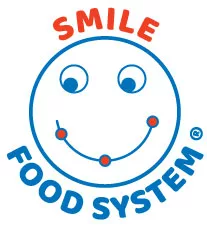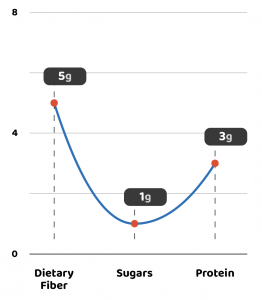Smile System Health Rating
The smile score, and its variants, show the relative levels of three critical food components: dietary fiber, added sugars, and protein. The ideal relationship is to consume sufficient fiber and protein, while avoiding excess added sugar. If shown on a graph, using the Smile Food System, fiber is on the left, added sugar is in the middle, and protein is on the right.
If the amount of grams in a food item of these three components are graphed and connected by a curving line, the ideal curve is a smile: high in fiber, low in added sugar, and high in protein. Variations include half smiles that are either high in fiber or protein but still low in added sugar. Caution is advised for foods that are high in either fiber or protein but also contain sugars that are higher than either fiber or protein; these are smile-frowns. A food item that is depicted by a frown should be avoided (unless it is intended as a treat or dessert): it has more added sugar than both fiber and protein.
Our rating is simply a mathematical operation on the nutrition facts of the food that reflects its ingredients and components. We are not providing merely a feeling or a personal preference. We simply graph the three key ingredients to reveal the nutrient composition of a food item to help inform your choices. This is objective. It is based on nutrition facts and nothing else. This fact-based graph is then interpreted with an understanding backed by a full consensus of medical and health authorities; namely that nutrient-dense foods are ones that tend to be higher in fiber or protein, or ideally both, than in added sugar (or total sugars, if you are tracking all sugar consumption).
Fiber, Sugar, and Protein Explained
Fiber is a type of carbohydrate that the body cannot break down. Therefore, it passes through the body undigested and can help regulate the absorption of many nutrients by slowing digestion. One of these nutrients that is absorbed at a “sluggish” rate is sugar, and this slowed absorption precludes spikes in blood sugar (also known as glucose). Without those spikes, you are steady and smooth in terms of hunger, without the “roller coaster“ of cyclical ups and downs of hunger, fast eating, hunger, more eating, and so on. Working in a dual manner, fiber also decreases the absorption of dietary cholesterol, which may help reduce certain harmful types of cholesterol in your blood (1). The slowed absorption of sugar, in tandem with the beneficial decreased absorption of cholesterol, may reduce the risk of type-2 diabetes, heart disease, and even some forms of cancer (2). Lastly, fiber aids in digestion by adding bulk, keeping your bowel movements regular while feeding your “good” gut bacteria. This reduces or precludes constipation and may lower the risk of colon cancer (2). Overall, fiber helps the body by slowing or decreasing the absorption of certain nutrients, keeping energy levels steady, preventing cravings for food brought on by “sugar crashes,” and keeping bowel movements regular.
Added sugars in foods are not considered to be an essential nutrient for the body. Added sugars are simple sugars, which are a type of carbohydrate, or “carb,” for short. Although carbs, primarily fiber, starch, and sugars, are indeed needed daily, the bulk of your carbohydrates can be fiber, starch, and natural sugars. The sugar, therefore, is not the essential part specifically, only the carbs are essential generally, and those can be obtained naturally from many nutrient-dense foods, such as fruits, vegetables, whole grains, and dairy products. Overall, you do need carbs daily … for energy, and for the brain, muscles, and other organs, but you can easily consume sufficient carbs without eating foods with added sugars. Avoiding added sugar in packaged products, however, can be difficult, for food manufacturers put sugar in many unexpected products, such as spaghetti sauce and salad dressing; thus, one should attempt to limit sugar intake to no more than 10% of daily calories (3), allowing for a portion of daily intake to come from intentional desserts or treats. The Smile Food System helps you make informed food choices and limit added sugar. Excessive intake of added sugar can increase the risk of disease: heart disease, obesity, type-2 diabetes, and depression. Aside from helping foods to taste sweet, excess added sugar consumption is not beneficial to one’s health. Eating excess sugar-saturated foods may displace a person’s consumption of healthy foods or simply add to overall calories without making a person feel satisfied and full from a meal. This can lead to excess calorie consumption (3). (Tracking of total sugars, in addition to added sugars, is an option within the Smile Food System.)
Protein is an essential macronutrient that the body requires for growth, tissue repair, immune function, essential hormones and enzymes, and overall good health (3). Dietary protein is made up of amino acids, which are the building blocks for muscles, bones, cartilage, and organs, including our skin. This even includes parts of the body like hair and nails. Dietary protein can help you look your best, physically, on the outside by making up muscle tissue, in addition to skin and hair. On the inside, dietary protein is crucial in the creation and maintenance of every cell in our body. It helps produce enzymes and other body chemicals that power the body, including aiding digestion, maintaining healthy hormone levels, and distributing oxygen throughout the body. Dietary protein is also hypothesized to be the most filling of the macronutrients according to the protein leverage hypothesis (4). This hypothesis predicts that people have a stronger appetite for protein than for the macronutrients carbohydrates and fat. As a result, people will remain feeling hungry until they eat enough protein in their diet. This means, if they are eating a diet low in protein but high in carbohydrates and fat, people will remain feeling hungry regardless of total calories eaten. Therefore, this may result in excessive energy intake when eating foods low in protein but high in total calories.
References
- Brown L, Rosner B, Willett WW, Sacks FM. Cholesterol-lowering effects of dietary fiber: a meta-analysis. Am J Clin Nutr 1999;69:30–42.
- Harvard T.H Chan School of Public Health. Fiber [Internet]. 2012 [cited 2022 Jan 21]. Available from: https://www.hsph.harvard.edu/nutritionsource/carbohydrates/fiber/
- U.S. Department of Agriculture and U.S. Department of Health and Human Services. Dietary Guidelines for Americans, 2020-2025. :164.
- Simpson SJ, Raubenheimer D. Obesity: the protein leverage hypothesis. Obes Rev 2005;6:133–42.

